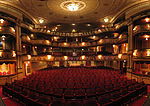Princes House, Brighton

Princes House (formerly Norwich Union House) is an office and residential building in the centre of Brighton, part of the English coastal city of Brighton and Hove. The prominently sited building, an example of Harry Stuart Goodhart-Rendel's "inimitable response to Modernism", was purpose-built as the headquarters of the Brighton & Sussex Building Society, forerunner of the Alliance & Leicester. The office was later used by Norwich Union, another financial institution, and now houses a restaurant and flats. The steel-framed structure is clad in red bricks with inlaid mosaicwork, forming a carefully detailed façade, and the corner elevation has an arrangement of brickwork and windows which suggests "the pleated folds of a curtain". The building is listed at Grade II for its architectural and historical importance.
Excerpt from the Wikipedia article Princes House, Brighton (License: CC BY-SA 3.0, Authors, Images).Princes House, Brighton
North Street, Brighton Round Hill
Geographical coordinates (GPS) Address Nearby Places Show on map
Geographical coordinates (GPS)
| Latitude | Longitude |
|---|---|
| N 50.822406 ° | E -0.139033 ° |
Address
Capital FM
North Street
BN1 1GL Brighton, Round Hill
England, United Kingdom
Open on Google Maps











